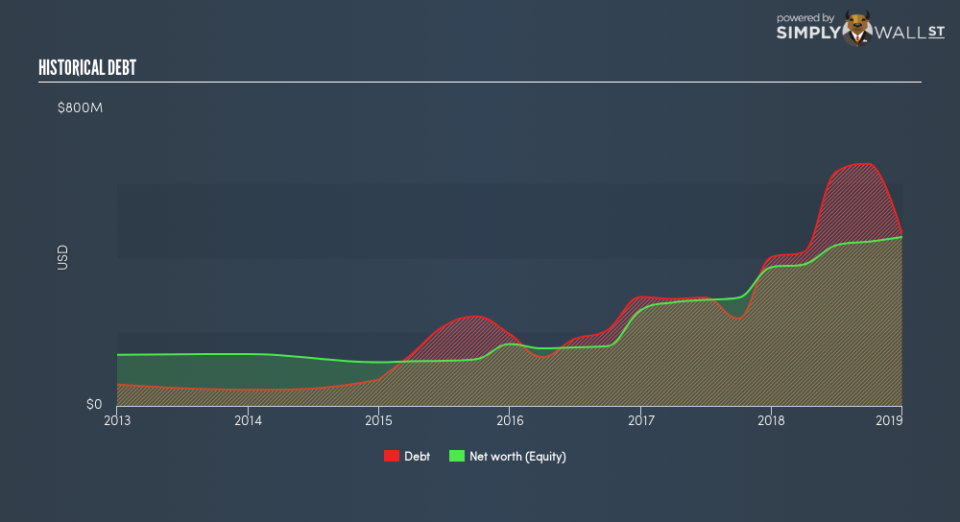What You Should Know About Equity Bancshares, Inc.’s (NASDAQ:EQBK) Risks

Want to participate in a short research study? Help shape the future of investing tools and you could win a $250 gift card!
The banking sector has been experiencing growth as a result of improving credit quality from post-GFC recovery. As a small-cap bank with a market capitalisation of US$522m, Equity Bancshares, Inc.’s (NASDAQ:EQBK) profit and value are directly affected by economic growth. This is because borrowers’ demand for, and ability to repay, their loans depend on the stability of their salaries and interest rates. Risk associated with repayment is measured by bad debt which is written off as an expense, impacting Equity Bancshares’s bottom line. Today we will analyse Equity Bancshares’s level of bad debt and liabilities in order to understand the risk involved with investing in the bank.
Check out our latest analysis for Equity Bancshares
How Good Is Equity Bancshares At Forecasting Its Risks?
Equity Bancshares’s understanding of its risk level can be estimated by its ability to forecast and provision for its bad loans. If it writes off more than 100% of the bad debt it provisioned for, then it has poorly anticipated the factors that may have contributed to a higher bad loan level which begs the question – does Equity Bancshares understand its own risk?. With an extremely low bad loan to bad debt ratio of 25.42%, Equity Bancshares has significantly under-provisioned by -74.58% which is well below the appropriate margin of error. This may be due to a one-off bad debt occurence or a constant underestimation of the factors contributing to its bad loan levels.
How Much Risk Is Too Much?
Equity Bancshares is engaging in risking lending practices if it is over-exposed to bad debt. Typically, loans that are “bad” and cannot be recuperated by the bank should comprise less than 3% of its total loans. Bad debt is written off when loans are not repaid. This is classified as an expense which directly impacts Equity Bancshares’s bottom line. Since bad loans only make up 1.69% of total assets for the bank, it exhibits prudent bad debt management and faces an industry-average risk of default.
How Big Is Equity Bancshares’s Safety Net?


Equity Bancshares operates by lending out its various forms of borrowings. Customers’ deposits tend to carry the smallest risk given the relatively stable interest rate and amount available. As a rule, a bank is considered less risky if it holds a higher level of deposits. Equity Bancshares’s total deposit level of 87% of its total liabilities is very high and is well-above the sensible level of 50% for financial institutions. This may mean the bank is too cautious with its level of its safer form of borrowing and has plenty of headroom to take on risker forms of liability.
Next Steps:
The recent acquisition is expected to bring more opportunities for EQBK, which in turn should lead to stronger growth. I would stay up-to-date on how this decision will affect the future of the business in terms of earnings growth and financial health. Below, I’ve listed three fundamental areas on Simply Wall St’s dashboard for a quick visualization on current trends for EQBK. I’ve also used this site as a source of data for my article.
Future Outlook: What are well-informed industry analysts predicting for EQBK’s future growth? Take a look at our free research report of analyst consensus for EQBK’s outlook.
Valuation: What is EQBK worth today? Has the future growth potential already been factored into the price? The intrinsic value infographic in our free research report helps visualize whether EQBK is currently mispriced by the market.
Other High-Performing Stocks: Are there other stocks that provide better prospects with proven track records? Explore our free list of these great stocks here.
To help readers see past the short term volatility of the financial market, we aim to bring you a long-term focused research analysis purely driven by fundamental data. Note that our analysis does not factor in the latest price-sensitive company announcements.
The author is an independent contributor and at the time of publication had no position in the stocks mentioned. For errors that warrant correction please contact the editor at editorial-team@simplywallst.com.

